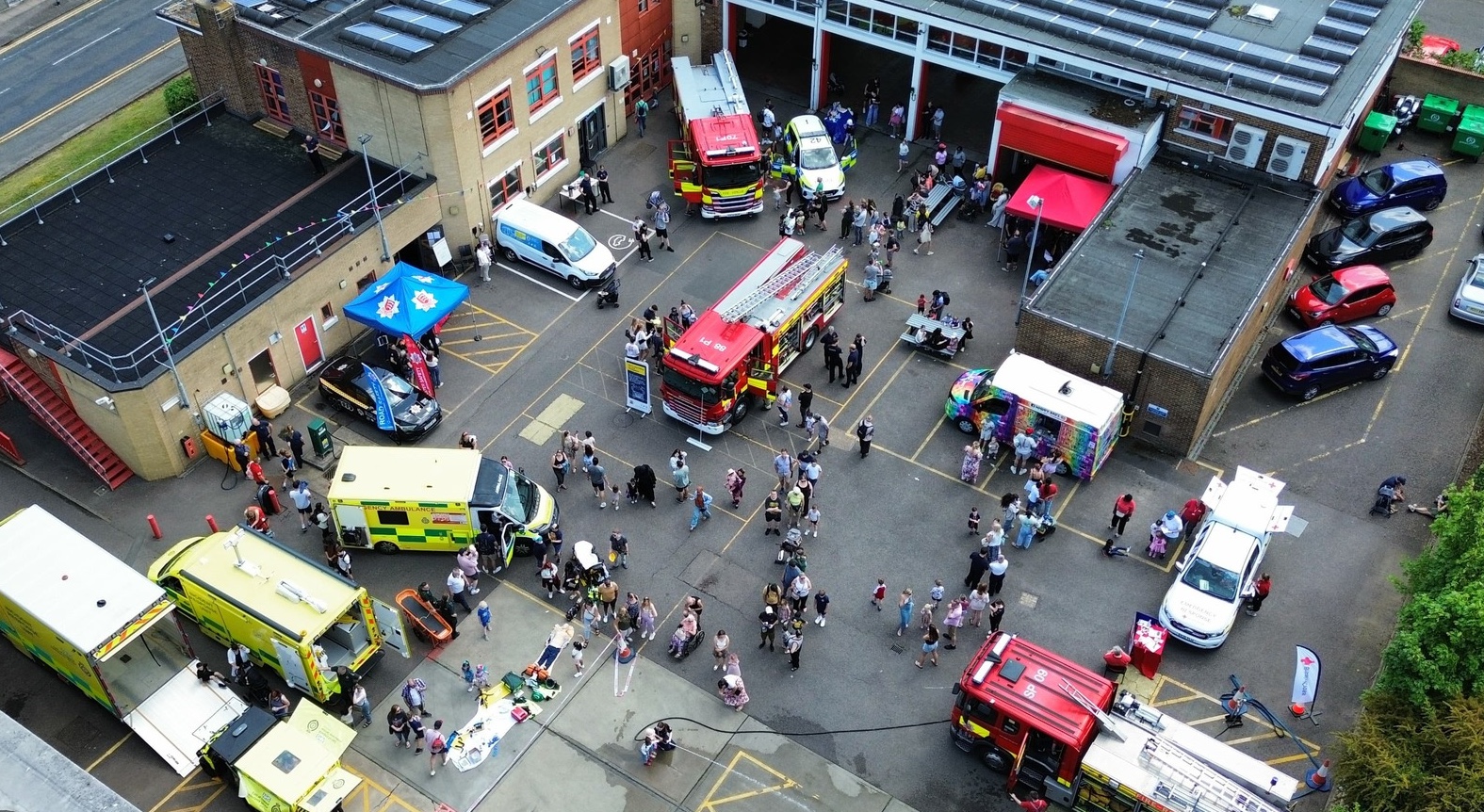Southend’s Unlucky Pier
The original wooden pier at Southend was built in the 1830s and was only 600m long while the current iron structure now in place was constructed in the 1890s.
The pier at Southend is well known for being the longest pleasure pier in the world, stretching out 1.33 miles into the Thames estuary. It also has a reputation for being dogged with mishaps having been bombed during World War One, struck by boats no less than six times and hit by several fires. It is of course the fires that are the focus here.
The first major fire occurred on 7 October 1959. A puff of smoke was seen coming from a room in one corner of the Victorian pavilion at the shore end. When the door to the room was opened the whole room was found to be on fire.The pavilion was a building mostly of wooden construction, used for conferences and other large functions. It could comfortably accommodate 1,000 people.
Fortunately the pavilion was empty at the time, but the pier itself did have visitors on it. Some four hundred to five hundred people were mostly at the pier head and they were all trapped on the pier as there was no way past the rapidly growing fire that had started to engulf the pavilion.
The trapped visitors were able to escape via small boats to the shore but in order to do so they had to make their way along the wooden planked pier towards the shore end and the rapidly growing fire. The electric railway soon had its power cut meaning those trapped on the pier had to walk the mile or so back towards the fire, in order to reach those rescue boats. With the risk of fire spreading along the wooden planks, it must have been quite a scary experience.
The fire was fully extinguished some four hours after the initial discovery.
The next big fire occurred at the pier head on Thursday 29 July 1976 and was first reported to Essex County Fire Brigade at 7.30pm. A worker in the amusement arcade had smelled smoke for some time and having investigated the smell discovered flames between the wooden planks outside the Sovereign’s bar. He tried to use a fire extinguisher but was unsuccessful. Having realised the flames were starting to gain a hold he sent another employee to call the fire brigade.
Visitors had by now begun to be evacuated from the pier head. Eleven people had to be rescued by boat from the pier head after they were cut off by the fire.
Three fire engines were sent; two from Southend Fire Station and one from Leigh-on-Sea Fire Station, this being the pre-determined attendance for any report of fire at the pier. At 7.36pm the officer in charge of Southend’s fire engines called for three more fire engines, a sure sign of a large fire. The first crews made use of the pier train to reach the fire, loading the train with hoses and other necessary equipment. By this time the buildings at the pier head had become engulfed in fire.
The firemen plugged a hose into the freshwater hydrant that runs the length of the pier but the pressure was low, hampering the initial firefighting effort. It was later discovered another hydrant on the freshwater main had been opened closer to the fire.
At 7.54pm the fire brigade were offered the use of two fire tugs that just so happened to be in the vicinity of the pier and had seen the column of smoke which had now become quite significant. The offer was gratefully accepted and these tugs provided the first proper firefighting attack on the fire whilst the fire brigade on the pier itself concentrated on preventing the fire from spreading back along the wooden planking. Later on another 5 fire tugs would join the firefighting effort.
At some point during the height of the fire a crop spraying aircraft dropped water on the fire from above but this proved to be ineffectual. At 9.25pm a five fire engine relief was set up and the fire was eventually extinguished around midnight though the fire brigade didn’t leave until 6.30pm the next day due to turning over and dampening down of hot spots.
In November 1977 a fire occurred in the roof of the bowling alley at the shore end. As the image to the left shows, this did cause damage to one panel on the side of the building but otherwise the fire was generally confined to the roof.
This wouldn’t be the last fire to affect this building.
At 8.28am on Wednesday 7 June 1995 the first of 27 calls were received by Essex County Fire & Rescue Service control reporting a fire at Southend Pier. Once again it was the bowling alley at the shore end. The predetermined attendance on this occasion was two fire engines plus an Aerial Ladder Platform and these were duly dispatched from Southend Fire Station. Due to the high number of calls, fire service control also sent a fire engine from Shoeburyness.
Upon arrival at the pier at 8.34am the officer in charge of the Southend fire engines requested a further three fire engines (to make six in total). As we know from the previous incidents, this initial request to increase the number of fire engines confirms to fire service control that this is a larger than usual fire. At 8.49am a request was made to further increase the number of fire engines to ten.
Just after 9am fire service control received the first informative message; “it is a building of two floors used as a bowling alley at the shore end of the pier, well alight, six jets, three ground monitors and breathing apparatus in use."
It’s obvious from this message that firefighters were making an aggressive attack on a significant fire. At some point during the initial stages of the fire, four people who were trapped on the pier had to be rescued by the RNLI lifeboat.
At 10.10am the number of fire engines required was increased to fifteen and at 10.30am a further informative message was received by fire service control; “it is a fire at the shore end of the pier, water relay in use, tide receding, alternative water supplies being established, four jets, two ground monitors in use. This update from the incident shows that firefighters were clearly struggling with water supplies in order to maintain their aggressive attack and had been forced to change their tactical plan.
Firefighters are well used to having to overcome and adapt as a given incident progresses and this fire would have been no different.
By 11am the number of fire engines required was increased to twenty.Whilst this fire was certainly of a similar size to the 1976 fire, the number of fire engines (and thus firefighters) used was far greater this time around.
A ten fire engine relief was set up for just after midday which allowed those first crews some respite; many of them had been battling the fire for some four hours straight. It’s not easy to appreciate the conditions they were working in but have a look at the images and just imagine how much heat that fire was giving off.
Their hard work paid off though – a few minutes before 1pm the message was sent to fire service control “fire surrounded”. It wasn’t completely extinguished but it certainly wasn’t spreading any further.
By midnight the number of fire engines had progressively been reduced to just one which had a watching brief overnight as hoses were tied in place covering particular hot spots. At 9am the next day two fire engines were sent to provide a relief and regular visits carried on throughout the rest of the evening and overnight checking that everything was now cool at the site of the fire.
The last visit was made at 11am on Friday 9 June.The cause of the fire was put down to an electrical fault within the roof of the bowling alley building.
Around 9.30pm on Sunday October 2005 a fire at Southend pier head was reported to Essex County Fire & Rescue Service control and the usual pre determined attendance was sent. The officer in charge of the first fire engine to arrive soon called for more fire engines as it was obvious this was no small fire.
The fire was in the vicinity of the of the McGinty’s pub, gift shop and the pier head railway station.
There was a nightwatchman at the pier head who had initially reported the fire and he had become trapped at the pier head as the fire grew. He was taken to shore at around midnight by the RNLI’s hovercraft. A number of fisherman were unaccounted for but were later found tucked up in bed at home.
At the height of the fire thirteen fire engines were sent though more would have been used as reliefs occurred throughout the night. The fire was more or less extinguished by 4am though turning over and dampening down of hotspots continued for a further three days as strong winds kept fanning the smouldering embers.


